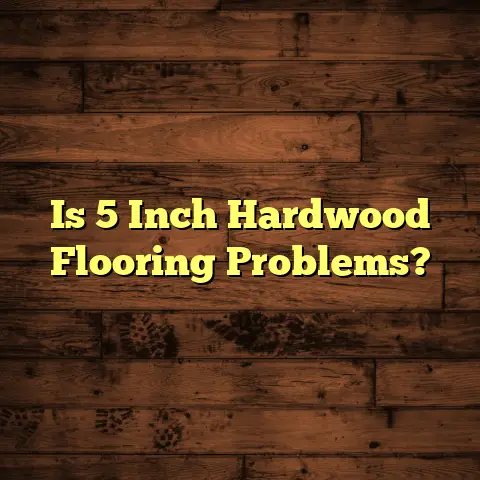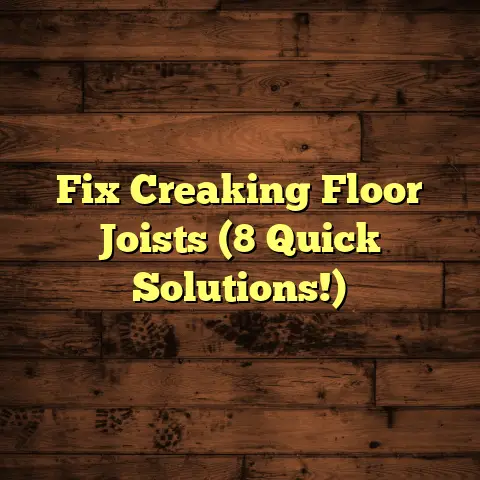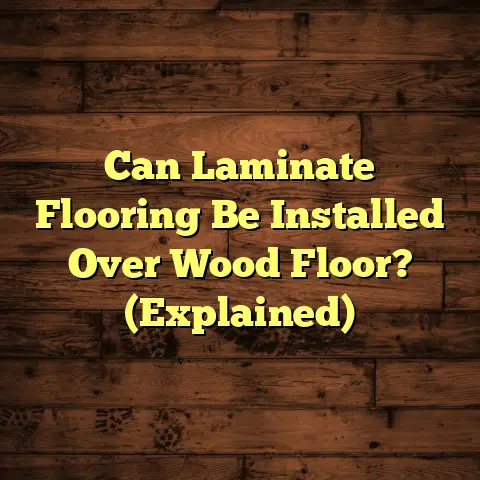Carpet vs Laminate Cost? (2 Cheaper Options?)
More and more homeowners are becoming eco-conscious, and that includes what they put on their floors.
We want something that looks great, lasts long, and doesn’t hurt the planet.
Today, we’re diving deep into the cost of carpet vs. laminate, plus I’ll share two cheaper, eco-friendly alternatives you might not have considered.
Let’s get started!
Section 1: Overview of Carpet Flooring
1. Definition and Types of Carpet
Carpet, at its core, is a textile floor covering made of woven fibers or tufted yarn.
Think of it as a cozy blanket for your floor!
The most common materials include:
- Nylon: Durable and stain-resistant.
- Polyester: Soft and budget-friendly.
- Olefin: Resists moisture and fading.
- Wool: Natural, luxurious, and long-lasting.
These materials are what give each carpet its unique feel and performance.
There’s a carpet style for every taste and need:
- Plush: Soft, smooth, and formal.
- Berber: Looped fibers, casual and durable.
- Frieze: Twisted fibers, hides dirt well.
- Cut-and-Loop: Combination of textures, adds visual interest.
I’ve installed miles of each type, and trust me, they all have their pros and cons!
2. Cost Breakdown of Carpet
So, how much does carpet actually cost?
The initial price depends on a few things:
- Fiber Type: Wool is pricier than polyester.
- Brand: Some brands command a premium.
- Density: Denser carpet lasts longer, costs more.
- Installation: Labor costs can vary widely.
On average, you can expect to pay anywhere from $2 to $12 per square foot installed.
Let’s break that down a bit:
| Factor | Price Range (per sq ft) | Notes |
|---|---|---|
| Carpet Material | \$1 – \$8 | Varies greatly by fiber type (Nylon, Polyester, Wool, etc.) |
| Underlayment | \$0.50 – \$2 | Crucial for comfort and longevity; impacts overall cost |
| Installation | \$0.50 – \$2 | Depends on complexity, room size, and local labor rates |
| Total | \$2 – \$12 | Wide range, reflecting choices in material, underlayment, and labor. |
Don’t forget the underlayment! It adds cushioning, insulation, and extends the life of your carpet.
A good quality underlayment can add another $0.50 to $2 per square foot.
3. Maintenance and Lifespan
Carpet needs regular TLC to look its best.
Vacuuming 1-2 times a week is a must.
Professional cleaning every 12-18 months helps remove embedded dirt and stains.
Spills should be tackled ASAP to prevent permanent damage.
With proper care, a good quality carpet can last 5-15 years.
However, cheaper carpets might only last 5-7 years before showing significant wear and tear.
That lifespan directly impacts the overall cost.
If you have to replace your carpet every five years, it’s going to cost you more in the long run than a higher-quality carpet that lasts 15 years.
Section 2: Overview of Laminate Flooring
1. Definition and Composition of Laminate
Laminate flooring is a synthetic flooring option that mimics the look of wood, tile, or stone.
It’s made of several layers:
- Wear Layer: A transparent top layer that protects against scratches and stains.
- Decorative Layer: A high-resolution image that gives the laminate its realistic appearance.
- Core Board: A dense fiberboard (HDF or MDF) that provides stability.
- Backing Layer: A moisture-resistant layer that prevents warping.
I’ve seen laminate transform rooms with its realistic wood-grain patterns!
2. Cost Breakdown of Laminate
Laminate is often seen as a budget-friendly alternative to hardwood.
But what’s the real cost?
Again, several factors influence the price:
- Thickness: Thicker laminate is more durable, costs more.
- AC Rating: Higher AC rating means better resistance to wear and tear.
- Brand: Just like carpet, some brands are pricier.
- Installation: Can be DIY or professionally installed.
Expect to pay around $3 to $10 per square foot installed.
Here’s a more detailed breakdown:
| Factor | Price Range (per sq ft) | Notes |
|---|---|---|
| Laminate Material | \$1 – \$6 | Dependent on thickness, AC rating, texture, and brand. |
| Underlayment | \$0.30 – \$1.50 | Crucial for sound reduction and moisture barrier; varies in quality and type. |
| Installation | \$1 – \$2.50 | Influenced by room complexity, subfloor condition, and labor costs. |
| Total Installed | \$3 – \$10 | Reflects choices in material, underlayment, and installation method. |
Underlayment is crucial for laminate too!
It provides a moisture barrier, sound insulation, and cushioning.
Factor in another $0.30 to $1.50 per square foot for underlayment.
3. Durability and Maintenance
Laminate is known for its durability.
It’s resistant to scratches, dents, and stains, making it a great choice for high-traffic areas and homes with pets.
Maintenance is a breeze – just sweep or vacuum regularly and mop with a damp cloth.
Avoid excessive water, as it can seep into the seams and cause swelling.
With proper care, laminate can last 10-20 years.
That’s a pretty solid lifespan!
Its resistance to wear and tear means you won’t be replacing it as frequently as some cheaper flooring options.
Section 3: Direct Cost Comparison: Carpet vs. Laminate
Alright, let’s get down to the nitty-gritty.
Which is cheaper, carpet or laminate?
1. Initial Costs
On average, carpet and laminate have a similar initial cost.
Carpet: $2 – $12 per square foot installed.
Laminate: $3 – $10 per square foot installed.
However, the type of carpet or laminate you choose can significantly impact the price.
A high-end wool carpet will cost considerably more than a basic laminate floor.
Conversely, a thick, high-AC-rated laminate can be more expensive than a low-end polyester carpet.
2. Long-Term Costs
This is where things get interesting.
While the initial cost might be similar, the long-term costs can vary widely.
Carpet: Requires more frequent cleaning and may need replacing sooner due to wear and tear.
Laminate: More durable and easier to maintain, but can be damaged by excessive moisture.
Let’s consider a scenario:
Imagine a 200 sq ft room.
Carpet (lower end):
- Initial cost: $4 per sq ft = $800
- Lifespan: 7 years
- Professional cleaning: $100 per year = $700 over 7 years
- Total cost over 7 years: $1500
- Replacement after 7 years: Another $800
- Total cost over 14 years: $2300
Laminate (mid-range):
- Initial cost: $6 per sq ft = $1200
- Lifespan: 14 years
- Minimal cleaning costs
- Total cost over 14 years: $1200
In this scenario, even though the laminate was more expensive initially, it ended up being cheaper over the long term because it lasted twice as long.
3. Value for Money
So, which offers better value for money?
It depends on your priorities.
If you want a soft, warm floor and are willing to invest in regular cleaning and potential replacement, carpet might be a good choice.
If you prioritize durability, low maintenance, and a longer lifespan, laminate might be a better bet.
From an environmental standpoint, both have their issues.
Traditional carpets can release VOCs (volatile organic compounds) and are often made from non-renewable resources.
Laminate can also contain VOCs and may not be easily recyclable.
That’s where our cheaper, eco-friendly alternatives come in!
Section 4: Two Cheaper Alternatives to Carpet and Laminate
Ready to explore some budget-friendly, eco-conscious options?
Here are two alternatives that I often recommend to my clients:
1. Vinyl Flooring
Vinyl flooring has come a long way in recent years.
It’s no longer the cheap, flimsy stuff you might remember from your grandma’s kitchen.
Today’s vinyl is durable, stylish, and affordable.
There are two main types:
- Sheet Vinyl: Large rolls that are easy to install and offer a seamless look.
- Vinyl Planks: Individual planks that mimic the look of wood or tile.
Cost: Vinyl flooring typically costs $2 to $7 per square foot installed.
Installation: Sheet vinyl can be tricky to install yourself, but vinyl planks are often DIY-friendly.
Maintenance: Easy to clean with a damp mop.
Eco-Friendly Options: Look for vinyl flooring made from recycled materials or with low-VOC emissions.
Some manufacturers are even creating bio-based vinyl using renewable resources.
2. Cork Flooring
Cork is a truly sustainable flooring option.
It’s made from the bark of cork oak trees, which regenerates every nine years without harming the tree.
Cork is naturally:
- Renewable: The bark grows back!
- Sustainable: Harvesting doesn’t harm the trees.
- Comfortable: Soft and cushioning underfoot.
- Insulating: Provides thermal and acoustic insulation.
- Water-resistant: Naturally resists moisture.
Cost: Cork flooring typically costs $3 to $8 per square foot installed.
Installation: Can be installed as tiles or planks.
Maintenance: Easy to clean with a damp mop.
Eco-Friendly Aspects: Cork is a rapidly renewable resource, and cork flooring is often made with low-VOC adhesives.
Plus, it can be recycled at the end of its life.
I’ve seen cork flooring add warmth and character to homes while being a responsible choice for the environment.
Conclusion: Making the Right Choice
Choosing the right flooring can feel overwhelming, but hopefully, this guide has helped you understand the costs and benefits of carpet, laminate, and two cheaper, eco-friendly alternatives.
Remember to consider both initial and long-term costs, as well as your personal preferences and lifestyle.
Think about:
- Your Budget: How much can you realistically spend?
- Your Lifestyle: Do you have kids or pets? High-traffic areas?
- Your Style: What look and feel do you want to achieve?
- Your Values: How important is sustainability to you?
By weighing these factors, you can make an informed decision that you’ll be happy with for years to come.
And who knows, maybe you’ll even surprise your friends with your eco-conscious flooring choice!
Happy flooring!





